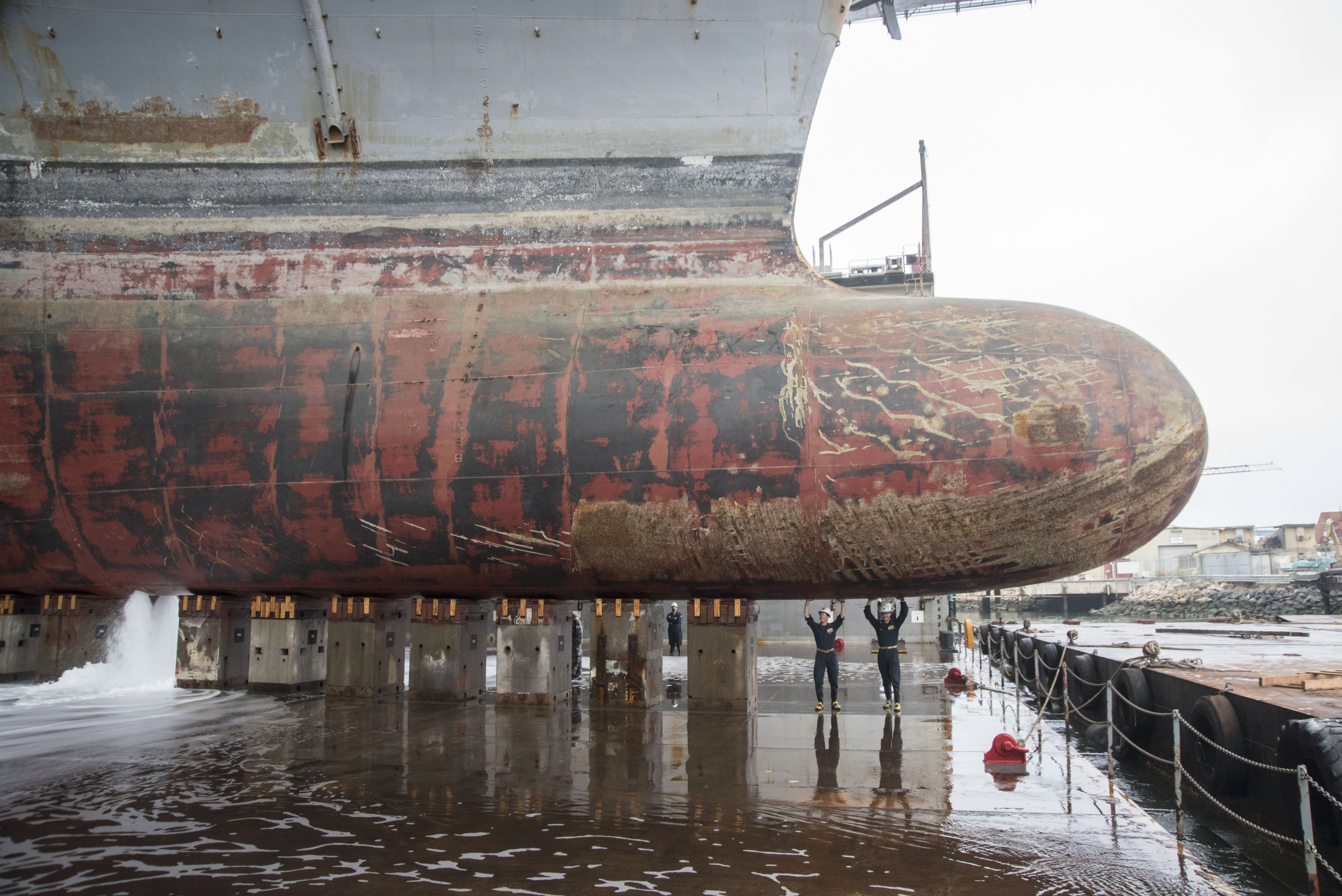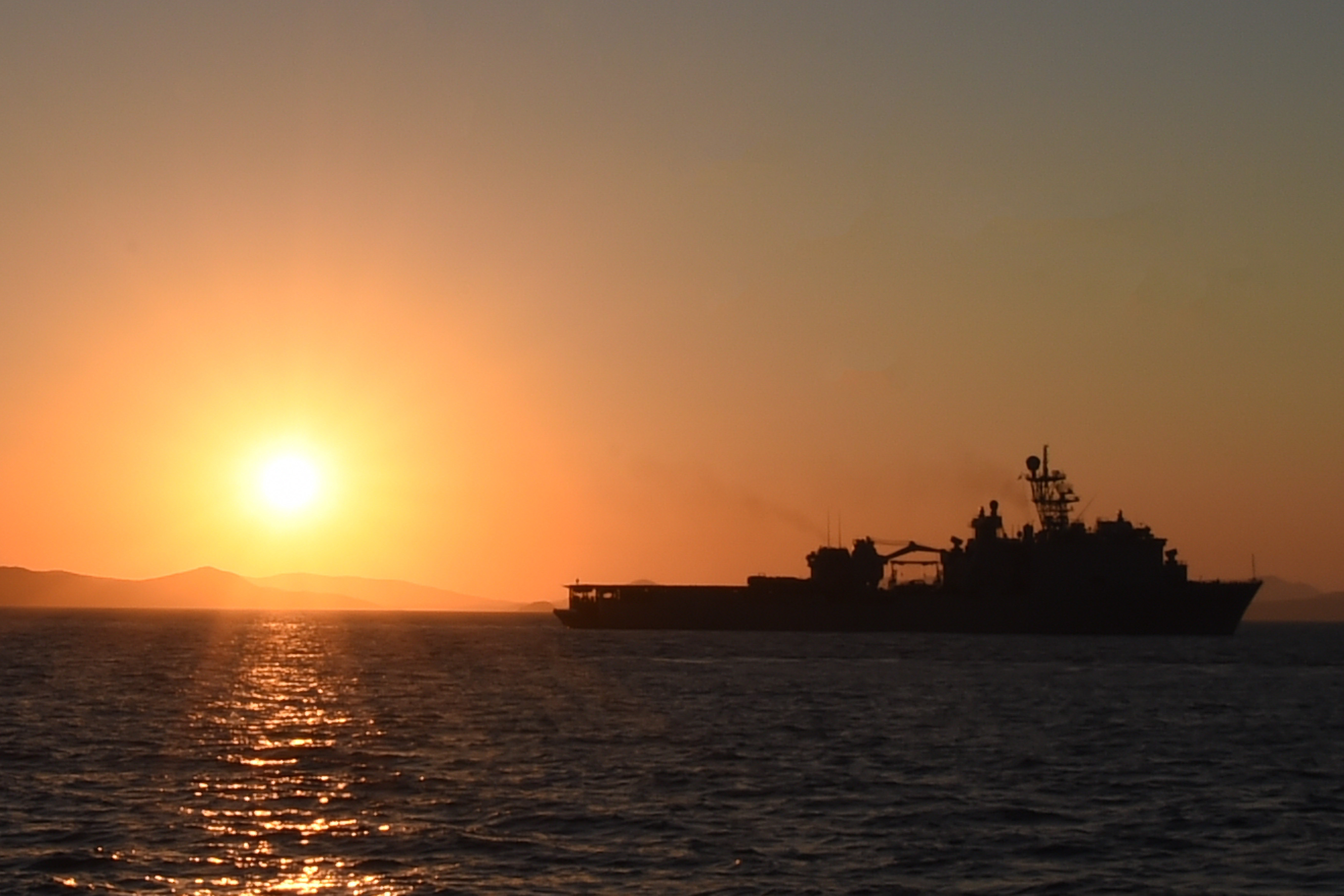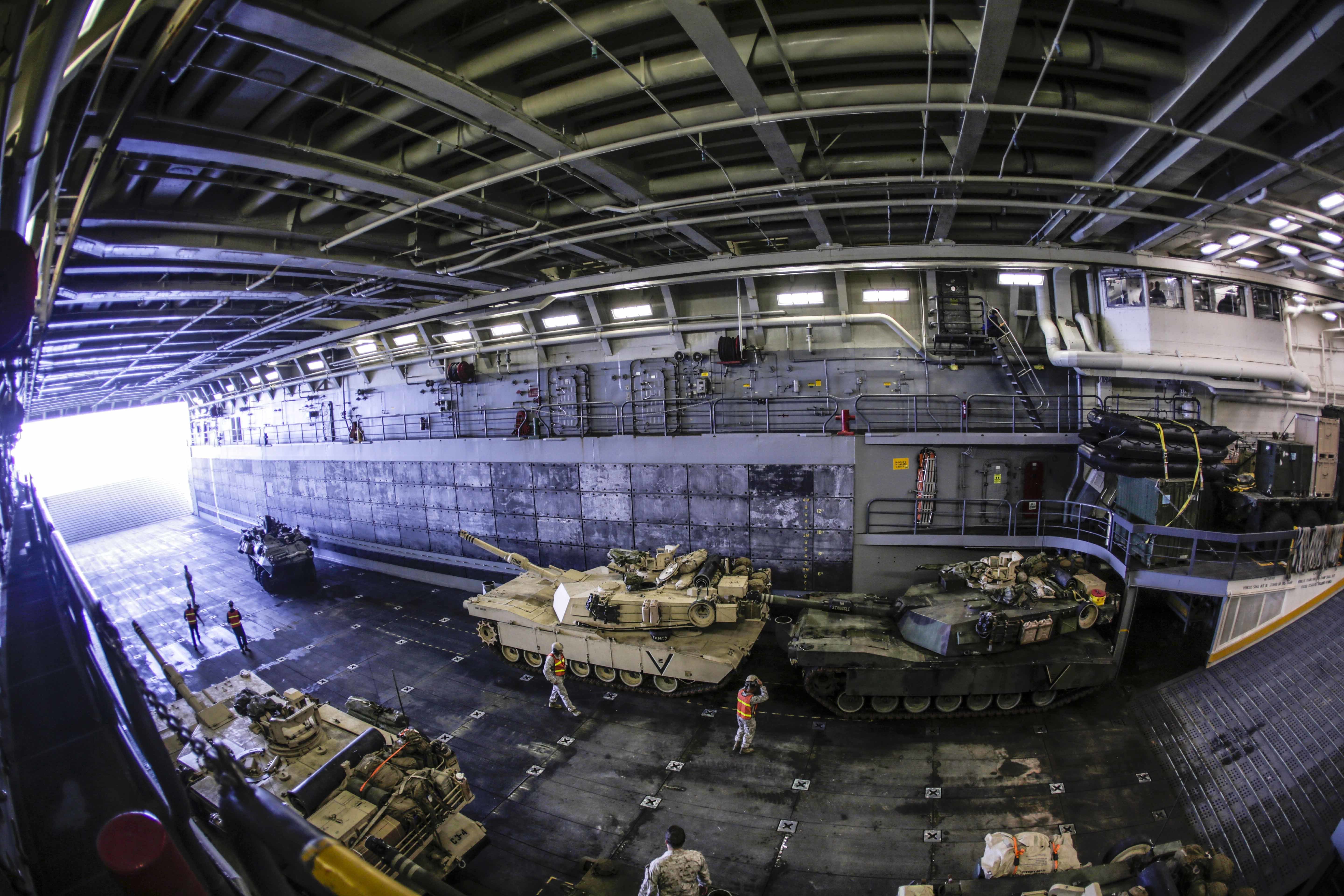
CAPITOL HILL – Nearly half the Navy’s amphibious ships are currently tied up in maintenance availabilities and the service would be several ships short of need if it had to scramble the fleet for a major contingency, in large part due to continuing resolutions and other budget challenges, top Navy and Marine Corps operations officials said today.
Vice Adm. Andrew Lewis, deputy chief of naval operations for operations, plans and strategy (OPNAV N3/N5), said at a House Armed Services readiness subcommittee hearing today that his number-one funding priority for the amphibious fleet is ship maintenance. The Navy and Marines are lacking available ships to conduct pre-deployment training, joint and international exercises, and concept development and experiments, and that ship availability issue stems from too many ships tied up in maintenance today, he said.
The Marine Corps’ years-old position is that “the Navy and Marine Corps Team require 38 amphibious warships, with an operational availability of 90 percent, to support two Marine Expeditionary Brigades, in order to provide the Nation a forcible entry capability,” according to the service’s 2017 posture statement. In that scenario, 34 amphibs could respond to a contingency if called upon, and four would remain behind in maintenance.
Today, the Navy is already short of that requirement with 31 commissioned amphibs in the fleet, and 14 of those are currently in maintenance, according to Lewis and Deputy Commandant of the Marine Corps for Plans, Policies, and Operations Lt. Gen. Brian Beaudreault. The admiral made clear that the 90-percent operational availability standard didn’t apply to any given moment in time but rather the ability to scramble ships out of maintenance and gear up to respond to a contingency. Even based on that standard, though, he told USNI News that “If the number [of required amphibious ships] is 30, we’re probably five or so short.”
Lewis squarely put the blame on the ongoing continuing resolutions. Using USS Gunston Hall (LSD-44) as an example, he said the dock landing ship had its last maintenance availability deferred by three years due to continuing resolutions – each year, the Navy had to make decisions about how to slow spending, and when Gunston Hall had to miss its planned start date at a private shipyard, it kept losing its place in line and couldn’t be squeezed in any sooner due to funding and scheduling concerns. Ultimately, when the availability finally took place, the delay “increased the cost from $44 million to $111 million. The time in maintenance went from 207 days to 696 days,” he said, since skipping important maintenance tends to lead to more broken parts and a larger scope of work when the maintenance finally gets done.

In addition to years of continuing resolutions wreaking havoc on ship maintenance scheduling and execution, Lewis added that the amphibious assault ships are spending more time in maintenance than planned due to the F-35B LIghting II Joint Strike Fighter interoperability upgrades taking more time than anticipated. The upgrade is meant to boost the ships’ computers and communications to keep up with the sophisticated new fighter, and to strengthen the flight deck to withstand the extreme heat of the exhaust in the vertical-landing jet.
“Those planned availabilities are longer than we thought they were going to be. We’re getting through them, we’ve got three ships that are modified,” he told USNI News, but added that the first couple availabilities took twice as long as expected and planned for.
“We’ve recalculated that; the scope of the work wasn’t fully understood. … It’s all programmed now, but we’re digging out of a hole. [The planning for the LHD availabilities] has been refined and modified, but it ends up costing more money. We’re trying to fill those coffers up to do that modernization, which takes a little priority. We’ve got a limited amount of money to do maintenance on ships. The first thing we do is do the maintenance on the ships that are next to deploy, and then it’s modernization.”
Beaudreault explained during the hearing that the lack of available ships for Navy-Marine Corps training at sea means an inability to “train at higher echelons above the Marine Expeditionary Unit and Amphibious Ready Group. Our forcible entry capability, core competency, in the Marine Corps in ’18 here is at risk,” he said. “we can add elements through virtual systems, but at some point you have to put the ships to sea and go through mission rehearsal. The ability to generate the number of ships required to train at a Marine Expeditionary Brigade level just simply isn’t there. so we take it in bite-sized chunks, we try to train elements of the MEB as best we can, but it’s very very difficult lacking the capacity to put the entire [Marine Air-Ground Task Force]/Navy team together.”
The Navy’s amphibious ship fleet is expected to grow in the coming years, reaching the 38-ship requirement in Fiscal Year 2033, Beaudreault said, but it is unclear how long the maintenance backlog will continue to affect amphibious training opportunities.
The Government Accountability Office today released a report noting the challenges the Navy and Marines have with finding sufficient ships to train on but adding that three major changes could be made to improve amphibious warfare training.

According to the report, “we found that each deploying Navy ARG completed training for the amphibious operations mission in accordance with training standards. Similarly, we found that each MEU completed all of its mission-essential tasks that are required during the pre-deployment training program. These mission-essential tasks cover areas such as amphibious raid, amphibious assault, and noncombatant evacuation operations, among other operations. However … Marine Corps units were unable to fully accomplish training for other amphibious operations priorities. These shortfalls include home-station unit training to support contingency requirements, service-level exercises, and experimentation and concept development for amphibious operations. For example, Marine Corps officials cited shortfalls in their ability to conduct service-level exercises that train individuals and units on amphibious operations-related skills, as well as provide opportunities to conduct experimentation and concept development for amphibious operations.”
Cary Russell, director of the GAO’s Defense Capabilities and Management Team, said at the hearing that the Marines rely on an ad hoc process to pick which units get to go to amphibious ships for training when the ships become available, rather than having a deliberate and prioritized process for assigning unit-level training, service-level exercises and experimentation events to available ships.
“the assignment of Navy ships to Marine Corps units was done more ad hoc based on the availability of units, Marine Corps units … rather than having a system of prioritization for those Marine Corps units that were most likely to need training earlier. So, for example, some of those units that might be tagged to go as part of the [Special Purpose MAGTF- Crisis Response], for example, or other things that might have priority. That distinction was not made in the process, rather it was more matching availability.”
GAO recommended that the Navy and Marine Corps create this type of prioritized list, and the Defense Department concurred and noted the “Secretary of the Navy would develop an amphibious operations training construct capitalizing on the application of primary and alternative training resources,” according to the report.
Second, the GAO report points out that “the Navy and Marine Corps do not systematically evaluate a full range of training resource alternatives to achieve amphibious operations priorities. Given the limited availability of amphibious ships for training, the Navy and Marine Corps have not systematically incorporated selected training resource alternatives into home-station training plans. During our review, we identified a number of alternatives that could help mitigate the risk to the services’ amphibious capability due to limited training opportunities. These alternatives could include utilizing additional training opportunities during an amphibious ship’s basic phase of training; using alternative platforms for training, such as [Maritime] Prepositioning Force ships; utilizing smaller Navy craft or pier-side ships to meet training requirements; and leveraging developmental and operational test events.”

The GAO “recommended that the Marine Corps develop guidance for the development and use of virtual training devices to address these gaps. DoD concurred with the recommendation and stated it would work with the Commandant of the Marine Corps in its development and implementation actions associated with the use of virtual training devices.”
During the hearing, Beaudreault said there was a system of systems of simulators and trainers that were relevant to amphibious operations around the edges, but there is not today a good simulator for amphibious operations as a whole that could replicate the on-ship experience his Marines need.
Third, the report notes the two services have worked on improving naval integration for training and operations but added that there was room for improvement. Suggestions for the services include writing “joint strategy that defines and articulates common outcomes to achieve naval integration,” establishing compatible policies and procedures to avoid inefficiencies during amphibious training events, and developing “mechanisms to monitor, evaluate, and report on results in improving naval integration.”





